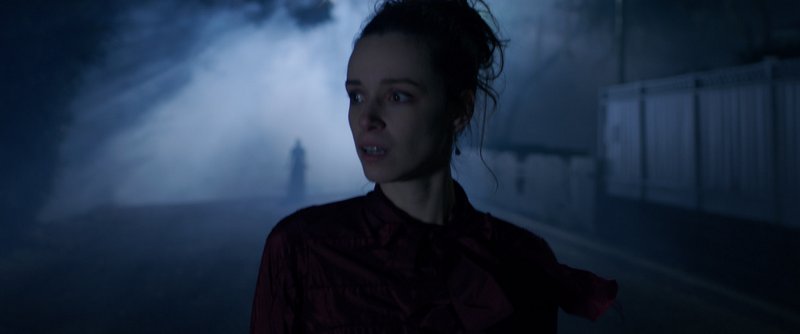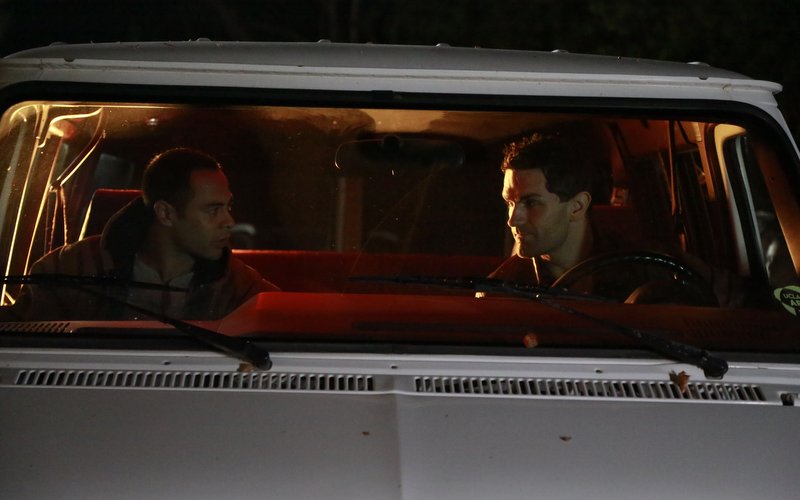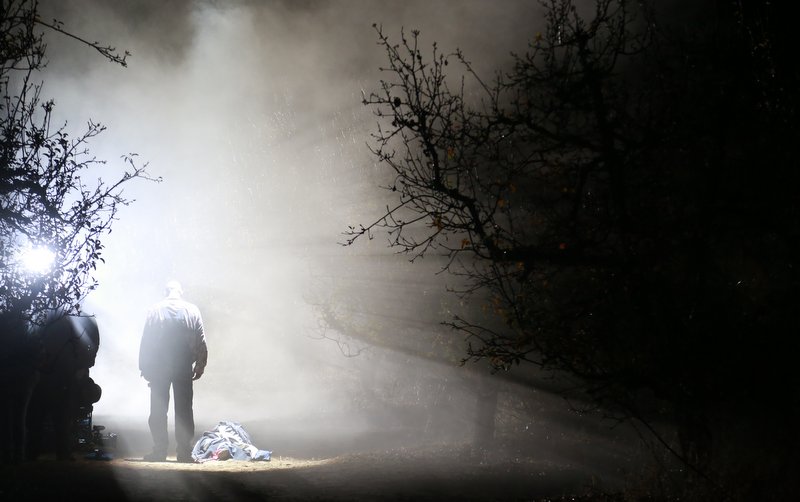
When Axelle Carolyn was a kid, she had a cousin who would tell her the most terrifying urban myths. Now, as one of the 11 directors known as the October Society, through their new anthology horror Tales of Halloween she gets to share a small but perfectly formed spooky tale of her own. She said, “Horror lends itself to bite-size chunks of spookiness.”
The bones of the October Society were laid a few years ago, when Carolyn was living in London and commuting regularly to Los Angeles. There she met a cabal of horror enthusiasts, including Darren Lynn Bousman (Saw II-IV), Adam Gierasch (Toolbox Murders), Lucky McKee (May, All Cheerleaders Die), and Neil Marshall (The Descent, Game of Thrones). The undectet joined together to conjure mini-nightmares for their hybrid creation. Carolyn said, “We’ve seen anthologies that have 26 stories and anthologies that have three, and we’re in the middle.”
Once a mainstay of horror, the anthology is undergoing a resurrection since Michael Dougherty’s modern classic, Trick ‘r Treat. Both V/H/S and The ABCs of Death have become full-blown franchises, while hell-headed road trip Southbound was a Fantastic Fest 2015 hit, and all-female directed XX is one of the most eagerly awaited horror films of 2016. Carolyn suggests the appeal to audiences is simple: “It’s that campfire feel.” Behind the camera, she sees anthologies as a way for directors to tell a story “without fitting into a career plan.” For example, Marshall is best known for cerebral shockers like Dog Soldiers, “and he comes up with this goofy killer-pumpkin story.” The format also allows lesser-known directors like Ryan Schifrin (Abominable, whose father Lalo Schifrin composed the Tales‘ theme) and Paul Solet (Grace) to be part of a much bigger production. She said, “If you can finance a film for Neil Marshall, that’s great, but if you can finance it for Neil Marshall and Mike Mendez and Lucky McKee, that’s fantastic.”
Producer/segment director Mike Mendez calls the team “the Avengers of Horror” and gives all credit to them assembling for this project to Carolyn. “The seed of the idea was Axelle’s. … It’s something I’m sure we’ve all thought about for a long time, but it’s a little bit of a pain to undertake. She was just like, why don’t we just make a movie together?” Yet while Carolyn lit the spark of the idea, Mendez knew that having a director of the star power of Marshall involved turned that ember into a flame. He said, “I’m such a fan of his, and he’s a good friend, and I respect him so much as a filmmaker, but I really felt that if he was on board, that really legitimizes it.”

Schifrin was another member of this loose alliance, having met the other members at horror and film conventions. He said, “Horror’s a small, tight-knit community, so all the directors know each other and are rooting for each other.” Like Mendez, he credits Carolyn: “This is her brainchild, to do this anthology based on Halloween. It’s her favorite holiday by far, and she’s seriously into Disney’s Haunted Mansion. We all love Halloween, but she takes it to another level.”
Together, Carolyn and Mendez made him a pitch he found hard to resist: “13 segments, one town, one night, and we have complete creative control as long as it fits into those parameters.” Schifrin admits that liberty was part of the appeal, but the whole concept spoke to him as a Halloween fan that builds a home haunt every All Hallow’s Eve. “There’s a lot of great horror films, but there are not a lot of films set specifically around the holiday. There’s Carpenter’s Halloween, there’s Trick’r’Treat, but it would be nice to have more things to watch on the holiday.”
Now with the directors on board, the hunt was on for a production company. Mendez had previously worked with Epic Pictures on, so he and Carolyn approached them with the pitch, a list of directors, and a budget proposal (“probably far lower than we should have tried for,” said Mendez). Less than a week later, they got the green light, with two slight changes: the 13 segments was now 10, and no found footage (no ding on found footage, it’s just that Epic was already handling V/H/S: Viral). “A year and a half later,” he said, “here we are, about to debut the movie.”
Of course, there was a whole lot of filmmaking to be done first. Before writing, Mendez said, the team looked at all the contemporary horror anthologies they could, “going back to the original Tales From the Crypt, Creepshow, Cat’s Eye, all the way up to V/H/S, The ABCs of Death, and really examined what makes some work and what makes some stronger than others.” The big takeaway was that they wanted to make it feel more cohesive, like the ’80s films, rather than the modern approach of letting each director go in their own direction. They also didn’t just throw a check at the filmmakers and leave them to flounder. “It was more like, what do you need to get this done? and then we’ll get it for you as one big production. That lent itself to unifying it as well, because it was a lot of the same crew, it was the same camera, and so we had the same sand box to play in.”
The instructions to the directors were simple: Everything happens on Halloween night in the same fictitious Middle American town. After that, it was up to them to create their own funhouse. Carolyn’s personal favorite segment is “Sweet Tooth”: Written and directed by Dave Parker (The Hills Run Red), it’s a bloody tale with more to fear from trick-or-treating candy than just cavities. Carolyn said, “To me, that’s the one that really encapsulates the spirit of what we are going for, which was spooky fun.”

But with a house style in place, the challenge was to make each segment different, “so they don’t all have teenage girls dying,” said Schifrin. His segment was also his return to the screen for the first time since his 2011 short “No rest for the Wicked”. Not that he’s been sat on his hands, having turned the short into the successful Basil and Moebius comic series, but that monster-laden thrill-ride short also shows the action-packed roots of his segment, “The Ransom of Rusty Rex.” He said, “I always gravitate to Tarantino films and Coen brothers films where there are underworld crooks who get into all kinds of mischief. So I had the idea that these two guys decided to kidnap the son of a wealthy man, but when they get him and take the mask off, they discover they’ve accidentally kidnapped a monster. Things go very haywire from there.”
According to Carolyn, while it was important to make the film feel like a complete whole, “We can recognize the style of each director.” That’s most obviously true with Mendez’s segment “Friday the 31st”, a madcap fusion of slasher, UFOlogy, and claymation. Probably most famous for shamelessly cheesy monster flicks like Big Ass Spider! and Lavantula, Mendez admitted that this was going to be a tough sell to his fellow directors. After all, he’d actually written it 17 years previously with fellow society member Dave Parker. That meant 17 years of failing to get it made. He said, “It was too weird. Imagine that.”
So, knowing the trouble he’d already had, he created a black and white animatic, “so you got a really clear idea of what it was, and fortunately people enjoyed it. The only bit of resistance I got was that an alien wasn’t particularly Halloween-y.”
Carolyn’s own segment, “Grimm Grinning Ghost,” employs restrained eeriness as a palate-cleanser. She said, “When I saw the other scripts, I thought that everyone was going for something scarier or more comedic.” In part, her segment was inspired by her cousin’s eerie stories, and in part by British TV show Mr Pye, and the moment when Derek Jacobi, illuminated by a single candle, sees his reflection and realizes huge goat horns have sprouted from his head. Carolyn said, “For years, I couldn’t look in a mirror.” Her story follows a young woman (Alexandra Essoe) as the proverbial girl walking home alone at night. She’s been at a Halloween party where someone told a traditional ghost tale, the kind you don’t want to hear when you’re destined for a mist-shrouded midnight lane. Carolyn was drawn to her lead actress by her breakthrough performance in Hollywood horror Starry Eyes. She said, “I went immediately to her and said, ‘We have to do something together, whether it’s this anthology or something else.'” While other members of the October Society treat all their characters as delightfully disposable blood bags, Carolyn’s story required a deeper connection to her imperiled heroine. She said, “I wanted people to care about her, or the payoff wouldn’t be as fun.”
(a shorter version of this interview originally ran at Austinchronicle.com)